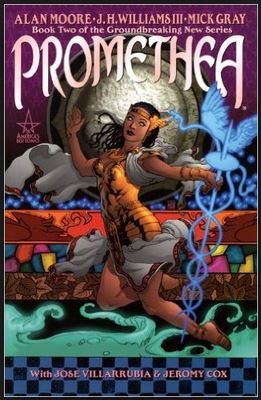
I’ve read a lot of books in my lifetime, so being completely blown away by a book has become a somewhat rare occurrence for me. This is a book that has completely blown me away. When I finished the last page, it was like a nuclear explosion of consciousness went off within my psyche. I have never seen such complex mystical ideas expressed so clearly and beautifully, both through the text and the illustrations. There is so much occult philosophy embedded in these pages, it’s impossible to do it justice in a short blog post, but I will try. I figure I will lightly touch on some of the themes and ideas that are incorporated into this work, and then elaborate on one chapter that demonstrates the complexity of this book.
Moore draws from a wealth of mythology and occult philosophy in the creation of Promethea, who is essentially the divine feminine manifestation of the Prometheus myth. This alone is a wonderful interpretation of the myth, about the bringing of enlightenment (symbolized by fire) to humankind. But like Yeats’ widening gyres, Moore expands on the myth by incorporating a plethora of allusions to occult philosophies and then ties them all together, showing the connection between the philosophies and myths throughout the millennia. Just to provide a sense of just how much is woven in, there are references to Aleister Crowley, Eliaphas Levi, the Goetia, Faust, the Vedic texts, kundalini, tantric yoga, kabbalah, tarot, alternate planes of existence, and the list goes on. The sheer amount of literary and visual symbolism on just a single page could spawn a lengthy analytical post.
So now I will attempt to give a very high-level summary of Chapter 6, the final chapter in the book.
In this chapter, Promethea, having studied the occult texts provided to her by Faust, realizes she has learned all she can about magick from reading and must now move into experiential learning. So she consults the two snakes that form the Caduceus, or the staff of Hermes. The twin serpents explain the occult history of humanity and all existence through the symbols of the 22 tarot cards that comprise the Major Arcana. Now, the explanation of each card and its symbolic connection to the evolution of being also includes many references to science, genetics, mysticism, numerology, kabbalah, etc. But for simplicity’s sake, I will only provide a brief summary of each card and its occult significance according to this book.
0 – The Fool: Symbolizes the nothingness or quantum void from which time and space are formed.
I – The Magician: Symbolizes the masculine creative urge, embodied in the phallic wand, which generates the initial spark or big bang.
II – The High Priestess: Symbolizes the highest female energy, the foetal darkness where all existence gestates. From her, the cosmos is born.
III – The Empress: Symbolizes fecundity and the seeds of life, along with the four elements. We now have the building blocks for life and consciousness.
IV – The Emperor: Symbolizes the moment when divine energy achieves substantiality.
V – The Hierophant: Symbolizes evolution, the visionary force that guides the first single cells to evolve into the first human hominid.
VI – The Lovers: Symbolizes sacred alchemy and the first spark of divine consciousness in humans.
VII – The Chariot: Symbolizes the advent of early shamanism and mysticism. Through the use of nectar, ambrosia, and soma, consciousness is expanded.
VIII – Justice: Symbolizes period of adjustment, where humans implement laws and build the foundations of civilization.
IX – The Hermit: Symbolizes a phase of entering a cave, from which will emerge a more developed and complex civilization.
X – The Wheel of Fortune: Symbolizes the cyclical rise and fall of civilizations: Babylon, Egypt, Greece, Rome, etc.
XI – Strength: Symbolizes lust, particularly for power, which is the impetus for conquering empires.
XII – The Hanged Man: Symbolizes man’s dark age, a necessary ordeal which marks the transition from the state of empire. The world is upside down.
XIII – Death: Symbolizes a period of transition, marking the end of dark ages before the rebirth of light.
XIV – Temperance: Symbolizes the Renaissance. Science, art, and beauty are combined alchemically.
XV – The Devil: Symbolizes the decline of the spiritual (Age of Reason). The inverted pentacle has four points (the four elements representing the earthly) while a single point (the spirit) is subjugated and trampled.
XVI – The Tower: Symbolizes Industrial Revolution, culminating in the first World War.
XVII – The Star: Symbolizes the renewed interest in mysticism and the occult following WWI. Here we have the birth of Theosophy, Golden Dawn, etc.
XVII – The Moon: Symbolizes mankind’s darkest hour before the dawn. Insanity. “Auschwitz, Hiroshima, each blight, each tyranny obscures the light.”
XIX – The Sun: Symbolizes the cultural revolution of the 1960s. Here we have new interest in Buddhism, astrology, I-Ching, and so forth.
XX – Judgment Day: Symbolizes the moment of apocalypse which will be brought about by the information age, once we reach the point where speed of technology and information causes a new form of consciousness to be born. (Note: Moore writes that this will occur in the year 2017.)
XXI – The Universe: Symbolizes the moment in which humans transcend the earthly plane of existence.
As I said earlier, there is no way I could do justice to this book in a short blog post. I strongly encourage you to read Promethea. Start with the first book and work through. There are I believe five books total. I have the third already waiting to be read. Expect to hear my thoughts on it soon.












You must be logged in to post a comment.